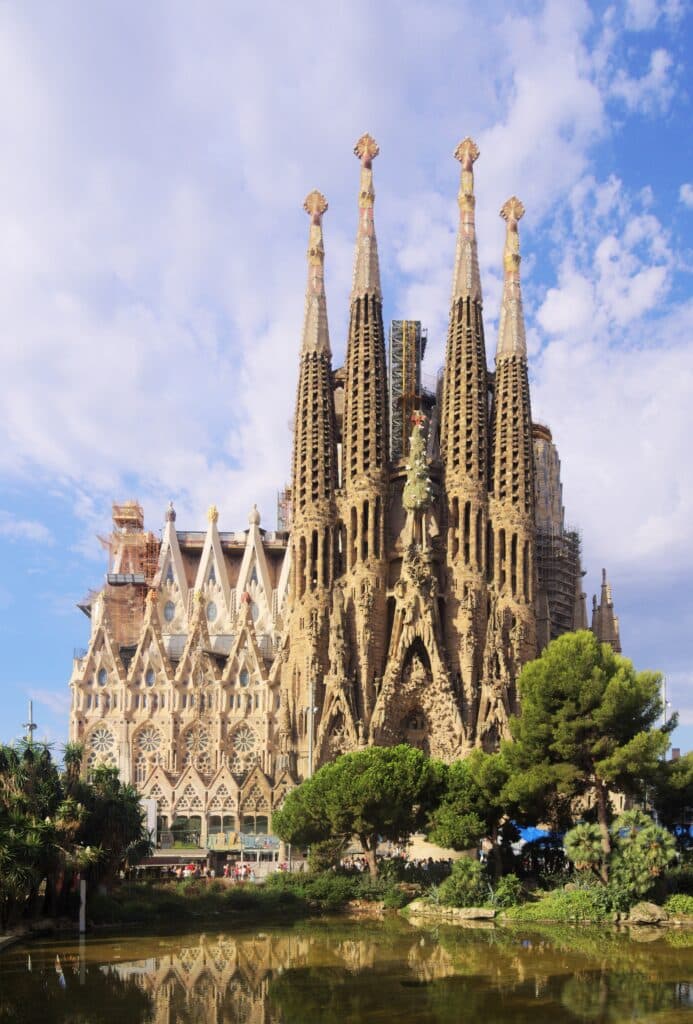Barcelona’s Sagrada Familia: An Inspiring Saga
Hey there, fellow travellers and architecture enthusiasts! If you’re planning a visit to Barcelona, you can’t miss out on the awe-inspiring wonder of the Sagrada Familia. Trust me; it’s a journey through history, faith, and an architect’s wildest dreams. Let me take you on a whirlwind tour of this iconic masterpiece, sharing some fascinating tidbits.
A Spiritual Beginning
In 1881, the Spiritual Association of the Devotees of Saint Joseph snagged a piece of land and dreamed big. They aimed to build a temple to honour Saint Joseph, but the real magic started on March 19, 1882. It was Saint Joseph’s Day when the very first stone was placed. Another architect, Francesc de Paula Villar, was initially on the job, but Antoni Gaudí took the reins in 1883. And boy, did he have grand plans.
Gaudí’s Grand Vision For Barcelona’s Sagrada Familia
Gaudí wasn’t one for half-measures. He envisioned a temple with five naves, a transept, an apse, an exterior ambulatory, three façades, and 18 towering spires. Yes, you heard that right—18! These towers symbolize biblical figures; 12 are apostles, 4 are evangelists, one represents the Virgin Mary, and the grandest of them all reaches a dizzying 172 meters, symbolizing Jesus Christ himself. The Sagrada Familia is set to be Barcelona’s tallest building and the world’s tallest church once it’s completed.

Gaudí’s Singular Dedication
From 1914 onwards, Gaudí put all his other projects on hold and gave his heart and soul to the Sagrada Familia. On November 30, 1925, the first bell tower of the Nativity façade was completed, but tragically, Gaudí never saw it finished. In June 1926, he met with a tragic accident, getting run over by a tram. The Nativity façade, the first part of the temple, was finally completed in 1930.
A Bump in the Road
After Gaudí’s passing, his disciple Domènec Sugrañes took up the mantle. But a fire ravaged the crypt during the Spanish Civil War, damaging the provisional schools and the workshop where Gaudí left his plans and models. Unfortunately, not everything was recovered, leaving a piece of Gaudí’s vision forever lost.

A Towering Feat
Did you know it took a whopping 22 years to construct the Passion façade, the temple’s second façade? Construction kicked off in 1954 and was finally wrapped up in 1976. They kept as close as possible to Gaudí’s original vision.
A Continuation of the Legacy
Since Gaudí’s passing, several architects have taken the helm, including Domènec Sugrañes, Isidre Puig Boada, Lluís Bonet I Garí, Francesc de Paula Cardoner Blanch, and Jordi Bonet Armengol. Jordi Faulí Oller holds the position and continues to bring Gaudí’s dream to life.
A Gift of Love and Faith
The Sagrada Familia’s construction relies solely on donations and personal contributions, alongside advances in construction technology. Thanks to this support, it will be finished within the planned timeframe.
A Blessing from the Pope
2010 Pope Benedict XVI visited the temple, declaring it a Basilica and leading a solemn mass.
A Monumental Finish
The big day is 2026, the centenary of Antoni Gaudí’s passing. It’s bound to be a profoundly emotional moment for Catalans and devotees worldwide. There’s even talk of Gaudí being declared a Saint of the Catholic Church, a proposal initiated in 2000 by the Association for the Beatification of Antoni Gaudí.
Why Visit Sagrada Familia
Do you know why you should visit this architectural marvel? Well, for starters, it’s Gaudí’s crowning achievement—a masterpiece that’s been in the making for over a century. The play of light and colours inside, as the sunlight dances through the stained glass, is pure magic and changes with the time of day.

A View from the Top
If you’re up for an adventure, you can even climb the towers for panoramic city views. The Nativity façade tower lets you ascend via a narrow spiral staircase, while the Passion Tower might be a better bet if you’re not keen on tight spaces or aren’t in the best shape.
Getting There
Ready to embark on this unforgettable journey? The Sagrada Familia’s address is C/ de la Marina N 41º 24′ 283″ | E 2º 10’486″. You can reach it by Metro L2 and L5 (Sagrada Familia stop) or by taking buses 19, 33, 34, 43, 44, 50, 51, B20, and B24. The general entrance is at the Nativity façade on C/ de la Marina.

Opening Hours
Don’t forget to check the opening hours before you go:
- From November to February: 9:00 AM to 6:00 PM.
- March and October: 9:00 AM to 7:00 PM.
- From April to September: 9:00 AM to 8:00 PM.
- December 25 and 26, and January 1 and 6: 9:00 AM to 2:00 PM.
So, there you have it, folks! The Sagrada Familia, a testament to human creativity, faith, and determination, awaits your visit. Take advantage of the chance to participate in this incredible journey through time and artistry.


